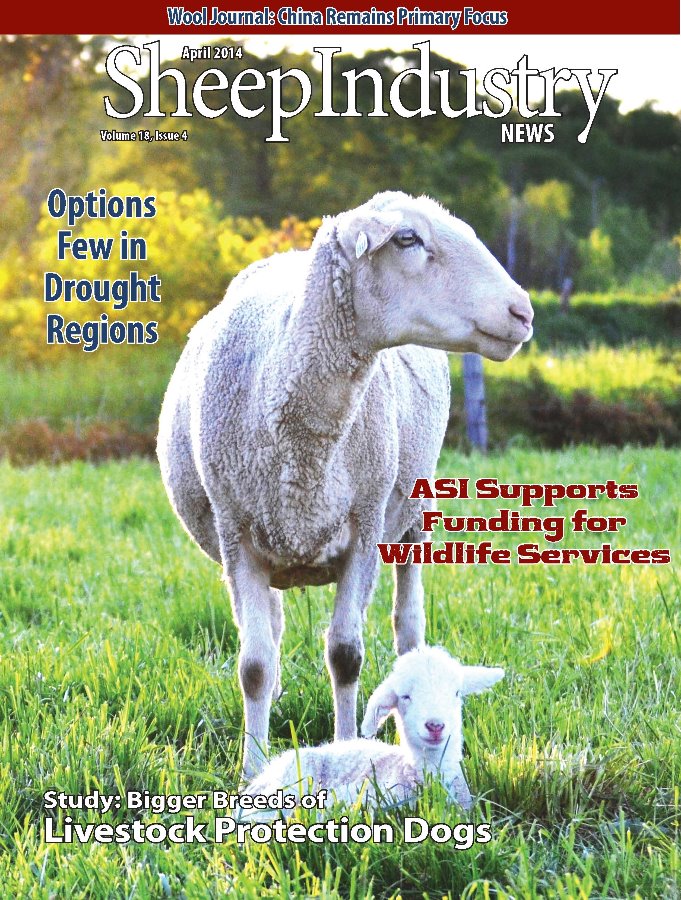
- April 2014
- President’s Notes
- Market Report
- ASI Takes Lead in Supporting Funding for Wildlife Services
- Larger LPD Breeds Being Considered
- Ranchers and Producers Affected by Drought Looking for Options
- States Release Wolf Reports, as Required by Feds
- Helping the Outdoor Industry ‘Rethink the Way it Sees Wool’
- Sheep Producer and Artist
- From Sheep Farm to Farm Bill
- Black Hills Stock Show Sheep Shearing Contest
Larger LPD breeds being considered
RALPH LOOS
Sheep Industry News Editor
Will larger and more aggressive livestock protection dogs solve wolf and grizzly bear problems facing U.S. sheep producers?
An ongoing study featuring three breeds of dogs rarely used in the U.S. could help answer that question. The U.S. Department of Agriculture’s Wildlife Services and the National Wildlife Research Center are leading the research, which includes 10 Kangal, nine Karakachan and nine Cão de Gado Transmontano dogs imported from Europe.
Julie Young, Ph.D., is leading the study at the NWRC Predator Research Center in Logan, Utah. She noted that current breeds of livestock protection dogs – Great Pyrenees, Komondors and Akbash – are losing many of the fights with larger predators like wolves and bears.
Last year, project researchers began their look at the effectiveness of larger, more assertive European dog breeds – specifically how those dogs could help ranchers protect flocks from grizzly bears and wolves in Idaho and Montana. Wildlife Services later expanded the project to Oregon, Washington and Wyoming.
“Finding suitable dog breeds for use as livestock protection dogs against wolves and bears not only helps us safeguard livestock and the livelihoods of ranchers, but also enhances and encourages coexistence between people and large predators,”said Wildlife Services Deputy Administrator William Clay.
Already, researchers have placed young dogs with commercial ranchers in several Western states and will monitor their movements and behavior using GPS collars and direct observations. To be effective, livestock protection dogs must bond with livestock and be fearless and aggressive toward predators, while not being aggressive toward other dogs or people. The dogs’ movements and behaviors are monitored using global position system (GPS) collars and direct observations. Care is taken to monitor for negative behaviors in the dogs, such as aggression towards other dogs, livestock or humans or an inability to bond to livestock.
Common in other sheep-producing countries, a resurgence in the use of dogs for sheep protection in the U.S. began in the 1970s. , Several factors contributed to this phenomenon, including Federal restrictions on the use of substances to kill predators, the relative inability of existing techniques to provide adequate relief from predation in certain situations, and a desire by some to use non-lethal methods of reducing the loss of livestock to predators.
Livestock protection dogs grow up and live with their flock, patrolling the perimeters of grazing areas to ward off potential predators.
Young said Wildlife Services supports the use of the digs for predation management and develops and distributes informational resources for livestock producers and others. Additionally, NWRC conducts research to identify improvements in the application of dogs for predator management.
Data is also being gathered on wolf and grizzly bear activities and movements in the study areas. Researchers hope to learn whether the European breeds can protect livestock from wolves and bears while also exhibiting appropriate temperaments for living with livestock in pens and on open lands.
Livestock Protection Dogs Being Studied
The KANGAL originated from the Kangal district in Sivas Province, Turkey. It is of an early mastiff type with a solid, pale tan or sabled coat, and with a black mask. The Kangal is not as heavy as some other mastiff breeds, allowing it greater speed and agility than larger dogs. The under-layer provides insulation against both severe winters and the fierce summers.
The KARAKACHAN originated in Bulgaria as a mountain livestock dog. The dog is named after the Karakachans, Balkan Greek nomadic shepherds. Karakachan dogs are large, long-haired, massive dogs with a well-developed musculature and wellexpressed sexual dimorphism. The Karakachan is strictly territorial. It accepts the flock as its territory.
The CAO DE GADO TRANSMONTANO is connected to the history of the Iberian Mastiffs and its evolution is linked to the migration route of the herds towards new pastures across the Iberian Peninsula. The character of these dogs is marked by a need of independence and self-sufficiency and that their temperament is dominant and patronising regarding other domestic animals.
LPD Basics
Livestock protection breeds originated in Europe and Asia, where they have been used for centuries to protect sheep from wolves and bears.
Some of the more common breeds are Great Pyrenees (France), Komondor (Hungary), Akbash dog and Anatolian Shepherd (Turkey), and Maremma (Italy).
Genetics and proper rearing both contribute to the makeup of a successful guarding dog.
A surge in the use of dogs to protect livestock in the United States took place in the 1970s.
Effective guarding dogs help livestock owners by reducing predation on sheep, reducing labor and alerting the owners to disturbances in the flock.
Experts suggest that LPD pups be reared with sheep at 8 weeks, with minimal human contact.

